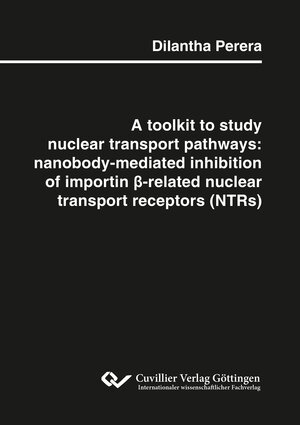A toolkit to study nuclear transport pathways: nanobody-mediated inhibition of importin β-related nuclear transport receptors (NTRs)
von Dilantha Pererahttps://cuvillier. de/de/shop/publications/8870-a-toolkit-to-study-nuclear-transport-pathways-nanobody-mediated-inhibition-of-importin-related-nuclear-transport-receptors-ntrs
Eukaryotic cells are divided into a nuclear and a cytoplasmic compartment. This separates transcription from translation and makes gene expression dependent on nucleocytoplasmic transport. The members of the importin β superfamily function as shuttling nuclear transport receptors (NTRs) that recognize and actively transport cargoes through nuclear pores. An estimated 5 000 to 10 000 different human proteins are subject to active nuclear transport. Numerous cargo/NTR pairs have been identified, however, we are still far from a complete understanding as it has been very challenging to setup a systematic in vivo analysis that integrates the impact of all transport pathways.
In this study, we obtained anti-NTR nanobodies against TRN1, Xpo4, Xpo7, and CAS. Our aim was to identify nanobodies, and prepare nanobody fusions, that impede nuclear pore-passage of the targeted NTR and thus, interrupt a given transport cycle. These nanobody fusions were observed to inhibit the partition of NTR/cargo complexes into a reconstituted FG phase. We also observed that the nanobodies and nanobody fusions inhibit NTR transport in permeabilized cells.
Eukaryotic cells are divided into a nuclear and a cytoplasmic compartment. This separates transcription from translation and makes gene expression dependent on nucleocytoplasmic transport. The members of the importin β superfamily function as shuttling nuclear transport receptors (NTRs) that recognize and actively transport cargoes through nuclear pores. An estimated 5 000 to 10 000 different human proteins are subject to active nuclear transport. Numerous cargo/NTR pairs have been identified, however, we are still far from a complete understanding as it has been very challenging to setup a systematic in vivo analysis that integrates the impact of all transport pathways.
In this study, we obtained anti-NTR nanobodies against TRN1, Xpo4, Xpo7, and CAS. Our aim was to identify nanobodies, and prepare nanobody fusions, that impede nuclear pore-passage of the targeted NTR and thus, interrupt a given transport cycle. These nanobody fusions were observed to inhibit the partition of NTR/cargo complexes into a reconstituted FG phase. We also observed that the nanobodies and nanobody fusions inhibit NTR transport in permeabilized cells.







